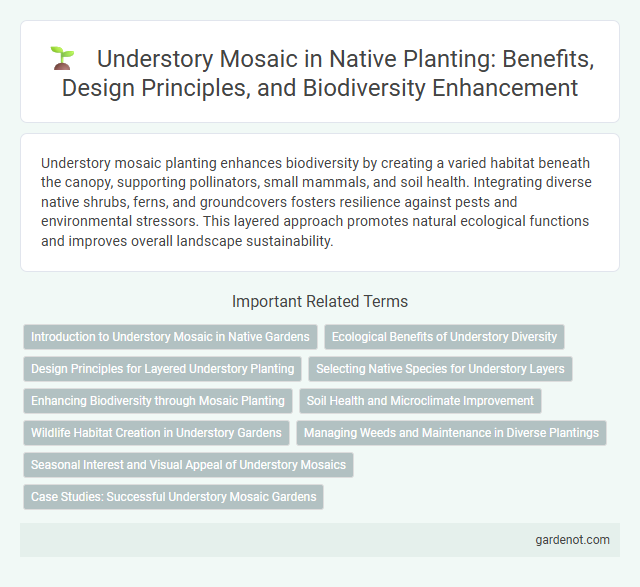Understory mosaic planting enhances biodiversity by creating a varied habitat beneath the canopy, supporting pollinators, small mammals, and soil health. Integrating diverse native shrubs, ferns, and groundcovers fosters resilience against pests and environmental stressors. This layered approach promotes natural ecological functions and improves overall landscape sustainability.
Introduction to Understory Mosaic in Native Gardens
Understory mosaic in native gardens involves planting diverse, low-growing vegetation beneath taller trees to create layered habitat complexity. This planting approach enhances biodiversity by providing shelter and food sources for pollinators, birds, and beneficial insects. Incorporating a variety of native shrubs, ferns, and wildflowers in the understory supports ecosystem health and soil stability.
Ecological Benefits of Understory Diversity
Understory mosaic planting enhances soil health by promoting nutrient cycling and reducing erosion through diverse root systems. This layered vegetation structure supports a wide range of pollinators, birds, and small mammals, increasing overall biodiversity and ecosystem resilience. Varied understory plants also improve microclimate regulation by moderating soil moisture and temperature fluctuations.
Design Principles for Layered Understory Planting
Understory mosaic design principles emphasize planting a diverse mix of native species that vary in height, texture, and color to create a visually appealing and ecologically functional layered habitat. Strategic placement of shade-tolerant perennials, shrubs, and groundcovers enhances soil health, supports pollinators, and promotes natural pest control by mimicking native forest understory complexity. Incorporating seasonal variation and native plant guilds maximizes biodiversity and resilience in layered understory planting systems.
Selecting Native Species for Understory Layers
Choosing native species for understory layers enhances ecosystem resilience, supports local wildlife, and improves soil health. Selecting shade-tolerant plants like ferns, wildflowers, and small shrubs ensures biodiversity and complements overstory trees. Incorporating native species such as Trillium, Spicebush, and Solomon's Seal creates a diverse and sustainable understory mosaic.
Enhancing Biodiversity through Mosaic Planting
Understory mosaic planting enhances biodiversity by creating diverse microhabitats that support various wildlife species, including pollinators, birds, and beneficial insects. This approach mimics natural forest layering, promoting ecological balance and improving soil health through increased organic matter and nutrient cycling. Strategic placement of native shrubs, herbs, and groundcovers in mosaics fosters resilience against pests and diseases while enriching overall ecosystem function.
Soil Health and Microclimate Improvement
Understory mosaic planting enhances soil health by increasing organic matter and promoting diverse microbial activity, which improves nutrient cycling and soil structure. This layered vegetation moderates microclimate conditions by providing shade, reducing soil temperature fluctuations, and maintaining moisture levels. Such microclimate stabilization fosters a resilient ecosystem that supports native plant growth and biodiversity.
Wildlife Habitat Creation in Understory Gardens
Understory mosaic planting enhances wildlife habitat by providing diverse structural layers and native plant species that support pollinators, birds, and small mammals. This approach increases biodiversity and creates shelter and food sources essential for local ecosystems. Strategic selection of shade-tolerant native shrubs, ferns, and groundcovers fosters resilient understory gardens crucial for habitat restoration.
Managing Weeds and Maintenance in Diverse Plantings
Understory mosaic plantings require careful management of weeds to prevent competition and ensure diverse native species thrive. Regular monitoring and targeted removal of invasive plants promote healthier growth and maintain ecosystem balance. Employing mulch and selective pruning supports soil moisture retention and reduces weed proliferation in diverse understory environments.
Seasonal Interest and Visual Appeal of Understory Mosaics
Understory mosaics enhance seasonal interest by showcasing a diverse array of native flowering plants, ferns, and shrubs that bloom and change color at different times of the year. The varied textures and leaf shapes create dynamic visual appeal, providing depth and contrast beneath the canopy. This layered planting approach supports biodiversity while offering continuous aesthetic value throughout all seasons.
Case Studies: Successful Understory Mosaic Gardens
Understory mosaic gardens showcase diverse native plant species thriving beneath mature tree canopies, enhancing biodiversity and soil health. Case studies from regions like the Pacific Northwest and Northeastern United States demonstrate how integrating native ferns, wildflowers, and shrubs creates resilient ecosystems with natural pest resistance. These successful gardens highlight the importance of selecting shade-tolerant understory plants to promote sustainability and habitat restoration.
Understory mosaic Infographic

 gardenot.com
gardenot.com